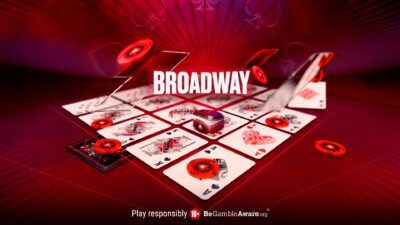There is a new poker strategy book due out this December from D&B Poker. In Why Alex Beats Bobbie at Poker, UCLA math professor Duncan Palamourdas uses human psychology, game theory, easy-to-understand mathematics and even some philosophy to explain how it is that some players consistently beat others.
As the title suggests, Palamourdas presents his ideas via a series of games and hands involving two poker players — Alex and Bobbie.
Alex is a poker pro who plays for a living and has won consistently over the long term. Bobbie is a recreational player who is decent enough but mainly plays poker for fun. In other words, Bobbie is a lot like the players most of us encounter in our games, while Alex is the kind of tough opponent we probably don’t face as much (unless we are full-time pros ourselves).
It makes sense that Alex would beat Bobbie more often than vice-versa. But why? What does Alex know that Bobbie doesn’t? That is what Palamourdas aims to explain in his book.
Palamourdas specializes in the mathematics of poker and poker education. He regularly teaches a poker course at UCLA for which enrollment is always full with long waiting lists.
His popularity as a poker teacher is partly a result of his love for simple language and metaphors. Why Alex Beats Bobbie at Poker demonstrates that affinity as Palamourdas explains a complex subject in simple terms without resorting to technical jargon. Topics covered include:
- Understanding the instinctive but unprofitable tendencies of inexperienced players
- How to identify what a mistake actually is in poker – and how to exploit it
- Why poker does not revolve around bluffing
- The great impact of variance in poker and how to account for it
- How to develop a consistent approach that allows you to play like Alex and not Bobbie
What follows is an exclusive excerpt from Why Alex Beats Bobbie at Poker in which Palamourdas discusses what is involved when “pure” bluffs work, as well as why players generally speaking don’t bluff often enough.
from “Poker is an Honest Game”
Have you ever wondered why pure bluffs work when they do? By pure, I mean situations where the person who does the betting has absolutely nothing (not even a draw) while the person who ends up folding has something decent, say at least a pair. Let’s consider the following situation in our typical $5/10 cash game with $1,000 effective stacks. Action folds to Alex who raises to $30 with Q♥ J♥ from MP and gets called by Bob from the BB. The flop comes:
Q♠ 8♠ 5♦ (pot: $65)
Bob checks and Alex fires a $40 bet to get some value from her top pair. To her surprise, Bob comes over the top with a hefty $200 raise! The action is back to Alex who thinks this is a very uncharacteristic line for Bob. He rarely raises without a strong hand like a set (ex: 5-5), two pair (ex: Q-8s) or at the very least top pair with a strong kicker (ex: A-Q). Of course, the fact that Bob made a gigantic raise (five times bigger than Alex’s initial wager) is not lost on her either. This could mean that Bob is either trying to force her out of the pot or that he is afraid that another spade may come and thus his monster holding could lose to a flush! Incidentally, Alex does not think that Bob has a draw because, if he did, he probably would have called and waited to complete it before putting more money in the middle. All in all, it appears that Bob is either bluffing or that he has a very big hand. And since, in her estimation, a bluff seems unlikely in this spot (much more unlikely than the 2-1 price Alex is getting on her call due to pot odds), she decides to calmly fold her top pair and live to fight another day.
Without skipping a beat, Bob — having won the pot — jumps out of his chair and slams his holding on the table face up even though he knows very well that he didn’t have to. 10♦ 2♦ ! “I had the Brunson! I could not resist!” Alex immediately smiles and politely taps the table saying “Very nice hand, sir!” Of course, Alex knows that she got bluffed out of the best hand. But how could she possibly have known that ahead of time without seeing Bob’s cards? The truth of the matter is, she could not have, and there is probably no way she ever would in a spot like this. Bob was likely to do the same thing with all the strong hands described above (sets, two pairs, and top pair top kicker). Since there are many more legitimate hands than bluffs that Bob could have in this spot, Alex knows that she made the right decision in the long run. This means that if a similar situation occurs in the future, she will correctly fold again. Having said that, Bob showing his cards is very useful to her. Alex now knows that 10-2 is a hand that Bob likes to play so she will certainly include it to his potential holdings next time she dissects his range!
Ok, so far so good. But let us go back to our original question? Why did Bob’s big bluff work so well even against a great player like Alex? The answer is because it is rare! In other words, Bob’s bluff is the exception, not the rule. If Alex had observed that Bob bluffs too much, she would never have folded her hand. The only reason Alex folded is because she thinks that Bob does not bluff enough in that spot! Let’s do some quick math to confirm this, assuming that Alex’s assumptions are correct. According to her, Bob could have had one of the following hands:
{A-Q, Q-8s, 8-8, 5-5, 10-2s}
Let’s also do a combo analysis on those. Taking into account that Alex already sees the Q♥ in her hand and the Q♠ 8♠ 5♦ on the board, the remaining combinations should be:
A-Q: 8 combos
Q-8s: 2 combos
8-8: 3 combos
5-5: 3 combos
10-2s: 4 combos
All in all, Alex loses to 8 + 2 + 3 + 3 = 16 combos while she beats only 4 (with the 4 being the theoretical random bluffs in this situation). That is exactly 4-to-1 against her. Since we established that the pot odds were close to 2-1, it should be clear that her failure rate is much higher than her reward. The math says she should fold! It is also worth noting that Alex does not need to know what hands Bob is bluffing with. All she needs to estimate is how frequently he bluffs. So as long as Bob bluffs with less than 8 combos (which is the threshold where her failure rate would match the pot odds: 2-1), she should fold every time! Exactly as she did.
To conclude, Alex should fold because Bob does not bluff enough in situations like these. Believe it or not, experience shows that low-frequency bluffers, like Bob, are not the exception. Rather, they are the rule in the vast majority of poker rooms across the country and even more so at lower stakes. Typically, players do not bluff nearly as much as they should. As a result, their betting actions are on average much closer to being “honest” (i.e., value hands) versus being “dishonest” (i.e., bluffs). This is what I like to call the Honesty Principle. An abbreviated version of it would be:
The Honesty Principle: On average and in the long run, Poker is an honest game.
By “honest,” I mean more honest than dishonest, in the sense that bets and raises are closer to being value-oriented, rather than bluff-oriented, as described above. An equivalent way of stating the principle is the following:
The Honesty Principle: As a whole, the poker community bluffs much less than it should.
By “should,” I mean as dictated by what is called the game theory optimal strategy of the game (or GTO for short). That is a foolproof strategy which guarantees (at a minimum) a fair share of return for the player who employs it regardless of how their opponents play. The caveat is that we do not know what this optimal strategy is, although we know that it exists thanks to the theoretical work of the great mathematician John Nash. That said, we can approximate this strategy “locally” (i.e., in certain segments of the game, as on the river, for example). What we see from experience is that humans on average bluff much less than they should. In other words, humans are imbalanced in a way that favors value bets over bluff bets, with the gap being wider with less experienced players.
Duncan Palamourdas’ Why Alex Beats Bobbie at Poker is available for pre-order in paperback or as an e-book from D&B Poker.
D&B Publishing (using the imprint D&B Poker) was created by Dan Addelman and Byron Jacobs 15 years ago. Since then it has become one of the leading publishers of poker books with titles by Phil Hellmuth, Jonathan Little, Mike Sexton, Chris Moorman, Dr. Patricia Cardner, Lance Bradley, Martin Harris and more, all of which are available at D&B Poker.
Back to Top






